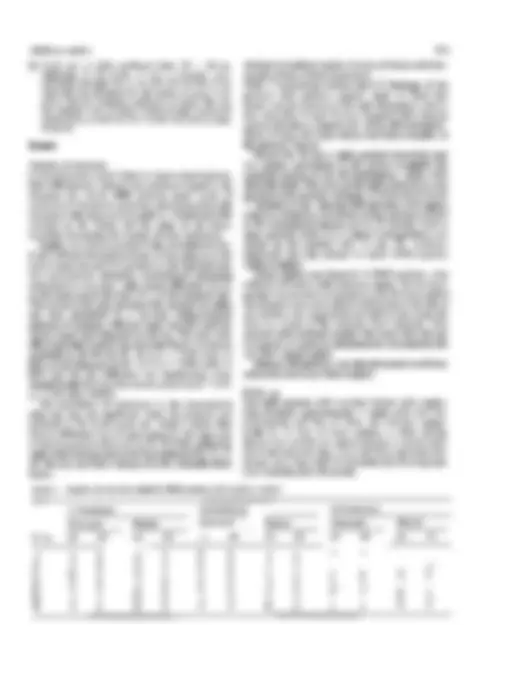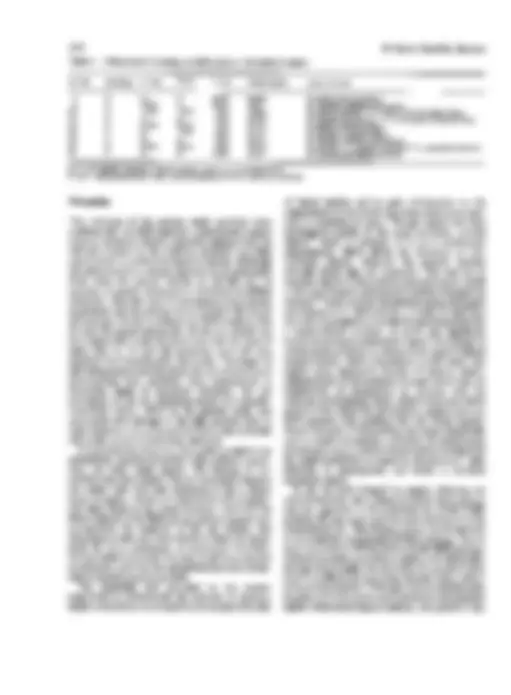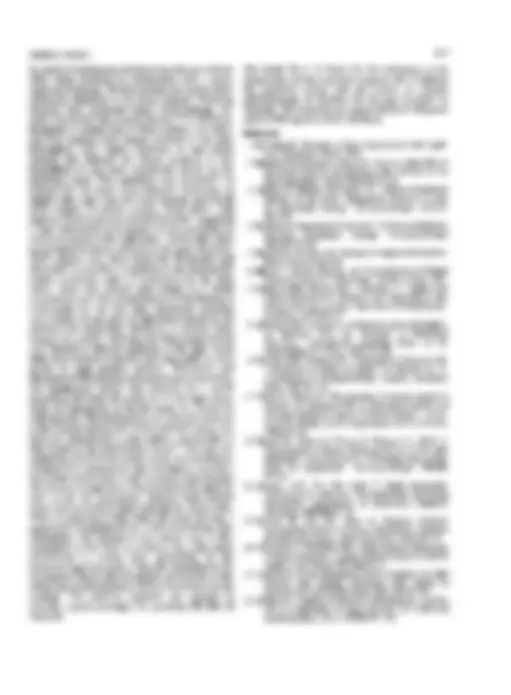





Study with the several resources on Docsity

Earn points by helping other students or get them with a premium plan


Prepare for your exams
Study with the several resources on Docsity

Earn points to download
Earn points by helping other students or get them with a premium plan
Community
Ask the community for help and clear up your study doubts
Discover the best universities in your country according to Docsity users
Free resources
Download our free guides on studying techniques, anxiety management strategies, and thesis advice from Docsity tutors
A research article published in the Journal of Neurology, Neurosurgery, and Psychiatry in 1989. The study investigates auditory neglect in normal controls and patients with unilateral hemispheric lesions. The authors required participants to detect interruptions in one ear using mono-aural and binaural presentations. The study found that control patients accurately detected interruptions, while patients with lesions in the parietal lobe or thalamus exhibited auditory neglect. The relationship between auditory neglect and auditory extinction was also investigated, and the findings were equivocal. The document also discusses the correlation between visual and auditory neglect and the participation of the right hemisphere in deploying attention to both contralateral and ipsilateral spaces.
Typology: Lecture notes
Uploaded on 09/12/2022
1 / 5

This page cannot be seen from the preview
Don't miss anything!




From the Neurological Department, Modena University, Modena, Italy
SUMMARY Auditory neglect was investigated in (^) normal controls and in patients with a recent unilateral hemispheric lesion, by requiring them (^) to detect the interruptions that occurred in one ear in a sound delivered through earphones either mono-aurally or binaurally. Control patients accurately detected interruptions. One left brain damaged (LBD) (^) patient missed only once in the ipsilateral ear while seven of the 30 right brain damaged (RBD) patients missed more than one (^) signal in the mono- aural test and nine patients did the same in the binaural (^) test. Omissions were always more marked in the left ear and in the binaural test with a significant ear by test (^) interaction. The lesion ofthese patients
neglect to auditory extinction was investigated and found to be equivocal, in that (^) there were seven
RBD patients without auditory neglect and the latter in two RBD patients without visual neglect. The finding that in some RBD patients with auditory neglect omissions also occurred, though with less frequency, in the right ear, points to a right hemisphere participation in the deployment of attention not only to the contralateral, but also to the ipsilateral space.
modality, where they manifest themselves as failure to
required to read a sentence, which lacks (^) meaning if
auditory stimuli having their source located in the left
stimulus located in^ the left space, except in response to double simultaneous stimulation. (^) Extinction, that (^) is,
Address for reprint requests: Dr Ennio De Renzi, Clinica Neurologica, Via Del Pozzo 71, 1-41100 Modena, Italy.
Received 10 May 1988 and in revised (^) form 3 December 1988. Accepted 12 December 1988
tics of acoustic stimuli and the (^) arrangement of the
ears, and can also lateralise it, though not accurately, by computing the time lag and the intensity difference with (^) which the right ear has been stimulated. It would appear that a prerequisite for bringing out auditory neglect, if it indeed (^) exists, is to confine the (^) acoustic stimulation to the ear contralateral to lesion. In this study we assessed the ability of brain- damaged patients with a recent (^) hemispheric disease (^) to monitor the interruptions that occurred at random intervals in one ear in a continuous sound delivered either unilaterally or bilaterally through earphones. We contrasted omissions in the ear contralateral and ipsilateral to the side of lesion and related them to the patients' manifestations of auditory extinction and visual neglect.
Material and methods
Subjects Fifty five patients participated in this investigation. Ten (^) were control (C) patients, hospitalised for diseases not (^) involving the brain (mean age: 56 4 yr), 15 were left (^) brain-damaged (LBD) patients (mean age: 61-2 yr) and 30 right brain- damaged (RBD) patients (mean age: 63-9 yr). Seven of the 15 LBD (^) patients were aphasic. The side of the lesion was based on clinical evidence and confirmed by CT in all patients, except two RBD patients who had negative CT findings, though showing unequivocal signs (left hemiparesis and hemianopia, respectively) of right hemisphere damage. In four RBD (^) patients CT also showed an old left vascular lesion that had been (^) clinically silent and in a fifth patient two silent left hemisphere (^) metastases in addition to a clinically evident metastasis of the right (^) hemisphere. Since neglect was the main subject of this investigation, the RBD (^) group selection was biased towards patients who presented clinically with signs of lateralised attentional disorders. Thus the (^) frequency with which neglect appears in the present sample cannot be generalised to the RBD population. Table 1 shows the clinical characteristics ofbrain-damaged patients.
Tests Patients were first submitted to pure tone audiometry to (^) rule out the presence ofmajor peripheral (^) deficits ofhearing and to ascertain whether there was an asymmetry between the (^) ear curves. If there was asymmetry the intensity of the (^) test signal delivered to the impaired ear was increased so as to equate the two (^) curves. It must be added that no patient with auditory neglect (see (^) below) showed a difference in threshold between ears.
Auditory attention test A sound generator delivered through (^) headphones to the patient a continuous 3000 Hz (^) pure tone at a level of 102 dB SPL; the sound lasted 4 minutes and was interrupted for 300 ms at intervals ranging from 8 to 20 ms. There were 24 interruptions, 12 per ear, to which the patient had to (^) respond by pressing the space bar ofa computer keyboard. The sound intensity could be adjusted independently in each channel in order to (^) compensate for hearing deficits, so that a (^) subjec- tively identical signal was provided to both ears in any case. The sound (^) generator was linked to an Apple II E computer by a^ versatile^ interface adaptor (6522). A computer program controlled the interruption pattern, specifically the 300 ms duration, the intervals between interruptions and the side of interruption in the binaural test. (^) Signal decay at interruption was (^) very fast, about 3 ms. The test (^) was presented in two versions, one^ mono-aural and^ the other binaural. In the mono-aural test the sound was first sent (^) to one ear until the 12 interruptions had occurred and then to the other ear, so that the patient knew where he had to focus attention. The order of ear presentation was pseudo-random. In the binaural test both ears received the sound, but the interruptions occurred quasi-randomly to either ear, with the restriction of no more than three consecutive interruptions to the same ear. In this case, therefore, the patient had to attend to both ears in order to perceive when the sound was interrupted. The following day the entire session was repeated and thus patients received (^48) signals per test, 24 in the right ear and 24 in the left ear. In the first session, patients were first familiarised with the procedure by the administration of a short version of either test with five 300 ms interruptions.
Auditory extinction Stimuli were delivered with two sound generators (75 dB), kept manually at a distance ofapproximately 10 cm from the ears, and (^) activated by pushing a button. Ten bilateral stimuli were administered, intermingled with 20 unilateral stimuli, 10 to the right and (^10) to the left ear. Responses were given by pointing with the forefinger to the ear (^) stimulated.
Visual neglect Two tests were given: (1) Reading test: The patient was (^) presented with a cardboard sheet, 41 cm x 29-5 cm, where the (^) sentence "La pera e caduta sotto l'albero" ("The pear has (^) fallen under the tree"), was written in 15 mm high (^) Letraset letters on a single line, 39 cm long. The patient was requested to read it aloud. Aphasics were encouraged to attempt reading, not (^) worrying about the errors they might make. If reading (^) proved to be impossible, they were requested to point to each word of (^) the sentence.
Table 1 Clinical characteristics ofbrain-damagedpatients
Aetiology Length ofillness* Parietalt Vascular Neoplastic (^) < 30 days > 30 days Visual neglect Aphasia involvement
RBD (^) patients (No: 30) 22 8 16 6 16 - (^15) LBD patients (^) (No: 15) 11 4 6 3 - (^7 )
*Vascular patients only. tBased on CT scan evidence.
Table 3 Clinical and (^) CTfindings in RBD patients with auditory neglect
De (^) Renzi, Gentilini, Barbieri
Pt. No. Aetiology V. Ext. T.Ext A. Ext (^) Visual neglect Locus oflesion
3 V nt nt 10/10 (^) severe R. inferior parietal infarct 4 V 10/10 nt 10/10 mild (^) R. thalamic-capsular haematoma 12 V 0/10 0/10 0/10 absent (^) R. inferior parietal + L. inferior parietal (old) infarct 15 V nt nt 4/10 severe (^) R. parietal haematoma + L. fronto-parietal (old) infarct 16 V (^) 10/10 10/10 2/10 severe (^) R. inferior parietal infarct 22 V nt 4/10 4/10 (^) severe R. thalamic-capsular infarct 23 V nt nt 9/10 severe (^) R. thalamic-capsular haematoma 28 N 10/10 10/10 0/10 absent (^) R. parietal + (^) L. parieto-occipital + L. occipital metastasis 30 V nt nt 10/10 severe (^) R. occipital and thalamic infarct
nt = not testable, because of severe somato- sensory or visual field defect. V. Ext.: visual extinction; T. Ext.: tactile extinction; A. Ext.: auditory extinction.
Discussion
the phenomenon is already apparent in an attenuated
dissociation indicates that extinction does not neces-
having neglect at its end, but may result from discrete
tion to neglect must be guarded.
humans91O tends to block the multiple unimodal (^) inputs
which results in failure to (^) attend to any type of stimuli
outcome of the present study, which (^) found nine RBD
with a (^) model envisaging a plurality of autonomous attentional control (^) systems decentralised at the level of
was also apparent (^) in the ipsilateral ear of five RBD
without contralateral auditory neglect, even those who showed visual neglect. In two of the five patients there
manifest left brain lesion never (^) produces contralateral
Auditory neglect
be raised ofwhether an old lesion may^ play^ an^ additive effect when occurring in combination with^ a^ recent right-sided damage. On this account one would expect ipsilateral omissions to be more frequent following bilateral than unilateral (right) brain-damage, but table 2 shows that this was not the case. It is, therefore, legitimate to assume that in these^ patients,^ not^ differ- ing from patients with disease confined^ to^ the^ right hemisphere, right^ neglect^ depended^ on^ right brain damage and reflected the unique property^ of^ this hemisphere to also exert^ attentional control^ on^ the ipsilateral space. This^ hypothesis^ was^ advanced78^ to account for the much^ more^ frequent^ occurrence^ of neglect after right than^ left^ brain^ damage^ and^ found some support in^ normal studies,^ where^ EEG'2 and regional cerebral glucose metabolism data'3 suggested a right hemisphere participation^ in the^ processing^ of stimuli presented to the right space. There is also some pathological evidence^ pointing^ in^ the^ same^ direction. RBD patients have been found by Weintraub and Mesulam'4 to manifest, in addition to the classical left neglect syndrome, signs of inattention for the right space, where they missed some targets in a visual cancellation test. The interpretation of this finding is confounded by the fact that rightwards scanning unavoidably brings part of right-sided stimuli in the patient's left visual field. However, it receives some support by a study'5 showing that when single stimuli were flashed in different positions of the right visual field, those located to the left were responded to more slowly by right parietal patients. Weintraub and Mesulam's RBD patients were also found to be mildly, but significantly slower than controls on a^ tactile searching task when the target was in the^ right^ space, while no impairment in the left space was^ shown^ by LBD patients. This finding hints at a delayed^ attention in the tactical exploration of the^ ipsilateral space,^ but does not demonstrate a true neglect, comparable to that found in the contralateral space.'6 The^ right^ ear omissions, found in^ the present study, provide definite evidence for a substantial right hemisphere^ contribu- tion to the monitoring of^ right-located^ events,^ because the absence of exploratory movements in the auditory task avoids the discrepancy between body-centred space and^ eye-centred^ space^ entailed^ by^ visual^ tasks. What is surprising is that while left brain damage is apparently compensated by a well-functioning right hemisphere, the opposite is not always true.^ Is^ this asymmetry to be taken as^ evidence that^ right^ space surveillance is exerted more powerfully by the ipsilateral right hemisphere than the contralateral left hemisphere? More data are needed, particularly on^ the behaviour of LBD patients, before a^ conclusion^ can^ be reached. The auditory attention^ test^ appears^ to provide a good paradigm for^ pursuing^ this^ line^ of research.
facilities. This research was^ supported by^ a^ CNR grant and an MPI^ grant^ to^ Dr^ E^ De^ Renzi.
1 De Renzi E. Disorders of Space Exploration and Cogni- tion. Chichester: Wiley, 1982. 2 Bisiach E, Cornacchia L, Sterzi R, Vallar G. Disorders^ of perceived auditory lateralization after lesions of the right hemisphere. Brain 1984;107:37-52. 3 Altman JA, Balonov LJ, Deglin DL.^ Effects of unilateral disorder of the brain. Hemisphere function in^ man on directional hearing. Neuropsychologia 1979;17: 295-301. 4 De Renzi E, Gentilini M, Pattacini F.^ Auditory extinction following hemisphere damage. Neuropsychologia 1984;22:733-44. 5 Barbieri C, De Renzi E. Patterns of neglect^ dissociation. Behav Neurol (in press). 6 Blauert J. Spatial Hearing: the Psychophysics of^ Human Sound Localisation. Cambridge: The^ MIT^ Press,^ 1983. 7 Heilman KM, Watson RT, Valenstein^ E.^ Neglect^ and related disorders. In:^ Heilman KM,^ Valenstein^ E,^ eds. Clinical Neuropsychology. New^ York:^ Oxford^ Univer- sity Press, 1985:243-93. 8 Mesulam MM.^ Attention,^ confusional^ states^ and^ neglect. In: Mesulam MM, ed.^ Principles^ of^ Behavioral Neurology. Contemporary^ neurology^ series,^ vol 26. Philadelphia: FA^ Davis,^ 1986:125-68. 9 Heilman KM, Watson RT, Valenstein E, Damasio AR. Localization of lesion in neglect. In: Kertesz A, ed. Localization in Neuropsychology. London: Academic Press, 1983:471-92. 10 Vallar G, Perani D. The anatomy of spatial neglect in humans. In: Jeannerod M, ed. Neurophysiological and Neuropsychological Aspects of Spatial Neglect. Advan- ces in Psychology, vol 45. Amsterdam: North Holland, 1986:235-58. 11 Bisiach E, Vallar G, Perani D, Papagno C, Berti^ A. Unawareness of disease following lesions of the^ right hemisphere: Anosognosia for^ hemiplegia and^ anosog-
471-82. 12 Heilman KM, Van Den^ Abell^ T.^ Right^ hemisphere dominance for attention: The mechanism underlying hemispheric asymmetries of inattention (neglect). Neurology 1980;30:327-30. 13 Reivich M, Gur RC, Alavi A. Positron emission tomographic studies of sensory stimulation, cognitive processes and anxiety. Hum Neurobiol 1983;2:25-33. 14 Weintraub S, Mesulam MM.^ Right cerebral^ dominance in (^) spatial attention. Further evidence based on spatial neglect. Arch Neurol^ 1987;44:621-5. 15 Ladavas E. Is the hemispatial deficit produced by right parietal lobe damage associated with^ retinal^ or gravitational coordinate?^ Brain^ 1987;110:^ 167-80. 16 De Renzi E, Faglioni P, Scotti^ G.^ Hemispheric^ contribu- tion to (^) exploration of space through the^ visual and tactile modality. Cortx 1970;6:191-203.